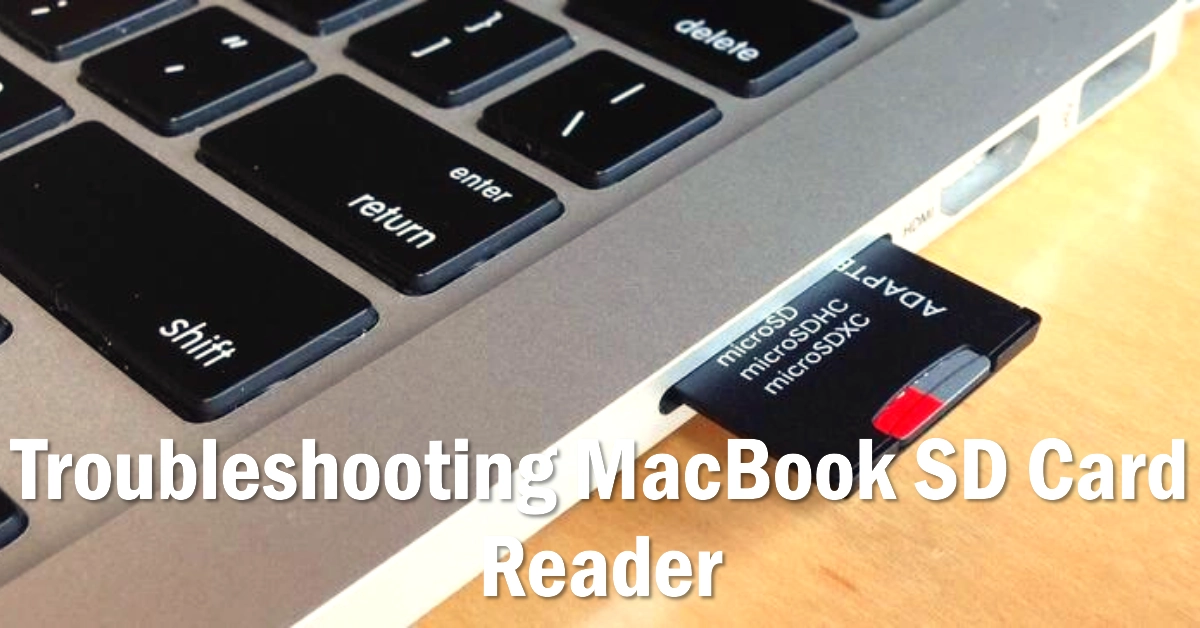SD cards are a convenient way to add storage or transfer files to your MacBook. However, there are times when you might plug in your card and find that your Mac doesn’t recognize it. The reasons behind this issue can range from simple oversight to more complex problems.
This article will help you diagnose and fix the issue, restoring your MacBook’s ability to interact with SD cards.
Common Causes: Why Your MacBook Might Not Read an SD Card
Before we dive into solutions, let’s cover the common reasons for this problem:
- Physical Issues: Check if the SD card is inserted correctly, the lock switch isn’t engaged, and that the card and slot are free of dirt or damage.
- Software Issues: Out-of-date macOS, incorrect Finder preferences, or file system errors may prevent card detection.
- File System Incompatibility: Ensure your SD card uses a file system that macOS supports (like FAT32, exFAT, or Mac OS Extended).
- SD Card Reader Problems: The MacBook’s internal card reader could be malfunctioning.
Now, let’s fix this!
1. Check the Basics
a. Ensure Correct Insertion
- Look at the SD card’s edge and find the notched corner.
- Match that notch to the shape of your MacBook’s SD card slot.
- Gently push the card in until you hear or feel a click.
b. Check for Physical Damage
- Inspect the SD card for signs of bending, warping, or damage to the metal connectors.
- Try a different SD card to rule out an issue with the card itself.
c. Try a Different Card Reader
- If you have an external SD card reader, test the SD card with it. This helps isolate any problems with your MacBook’s built-in reader.
2. Verify Finder Preferences
a. Open Finder
- Click on the “Finder” menu in the top left corner of your screen.
- Select “Preferences.”
b. Navigate to the Sidebar Tab
- Click the “Sidebar” tab.
c. Enable External Disks
- Under the “Locations” section, ensure the checkbox next to “External Disks” is selected. This setting ensures that your Mac displays SD cards on your desktop and in the Finder sidebar.
3. Restart Your MacBook
Sometimes a simple restart can fix temporary glitches. Click the Apple icon in the top-left corner of your screen and select “Restart.” After the restart, insert the SD card and see if your MacBook recognizes it.
4. Disk Utility
a. Open Disk Utility
- Go to Applications > Utilities > Disk Utility
b. Check for the SD card
- Look for your SD card in the list of drives on the left side of the Disk Utility window. If it doesn’t appear, there may be a connection issue or problem with the card itself.
c. Mount the SD Card
- If the SD card is listed but not mounted, select it and click the “Mount” button.
d. First Aid
- If your SD card appears in Disk Utility, run “First Aid” to check for and repair minor file system errors. Select the SD card and click “First Aid”. Follow the prompts on screen.
5. Reset NVRAM/PRAM
Non-volatile Random-Access Memory (NVRAM) or Parameter RAM (PRAM) stores certain settings on your Mac that might interfere with external device recognition. Here’s how to reset it:
- Shut down your MacBook
- Press and hold the Option + Command + P + R keys while turning on your Mac.
- Release the keys after about 20 seconds or when you hear the startup chime for the second time.
6. Format the SD Card
Important Note: Formatting will erase all data on the SD card. Back up any important files before proceeding.
- Open Disk Utility, select the SD card, and click “Erase.”
- Choose a file system (exFAT is widely compatible).
- Click “Erase” and wait for the process to complete.
Following these steps should help resolve most SD card issues on your MacBook. If your SD card still isn’t recognized, consider consulting a professional for further diagnosis as there could be hardware problems with your Mac’s SD card reader.
Frequently Asked Questions
1. Why is my MacBook not detecting any SD cards? There could be several reasons:
- Incorrect insertion: Double-check the card’s orientation.
- Damaged SD card reader: Try an external card reader.
- Software conflicts: Restart your Mac or reset the NVRAM/PRAM.
- Hardware failure: A faulty SD card reader may require professional repair.
2. My SD card was working before, but now it’s not. What could be wrong?
- File system corruption: Use Disk Utility’s “First Aid” function to repair minor errors.
- Physical damage: SD cards can be fragile; check for scratches or bent connectors.
- Outdated drivers: (Less common on Macs) Ensure your macOS is up-to-date.
3. The SD card shows up in Disk Utility but won’t mount. What should I do?
- Try manually mounting it: Select the card in Disk Utility and click “Mount.”
- Incorrect format: Your Mac may not support the SD card’s file system. Reformat it to a compatible format like exFAT.
4. Can I recover data from a corrupted SD card that my MacBook won’t read?
- Yes, potentially. Specialized data recovery software may help. Stop using the card immediately to avoid overwriting data. Consider professional recovery services for severe cases.
5. How do I prevent future SD card issues with my MacBook?
- Handle with care: Avoid bending or dropping your SD cards.
- Eject properly: Always eject SD cards before removing them.
- Use reliable brands: Invest in quality SD cards from reputable manufacturers.
